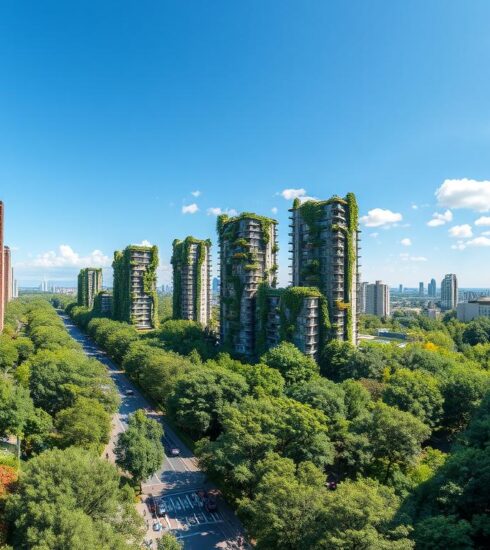Beyond the Glass Towers: Human-Centred Urban Design in Vancouver
- Jackie De Burca
- November 20, 2024
Vancouver, a pioneer in high-density urban development, is evolving beyond its well-known ‘Vancouverism’ model1. The city’s urban landscape is diversifying, with a focus on luxury housing and a tech-fueled office boom. A record 3.96 million square feet of office space is under construction downtown, with 65% of buildings planned for 2022-2023 already leased, primarily by tech companies2. City planners are aiming to enhance building design, focusing on public spaces and revitalising neighbourhoods outside the central core. Alexandra Steed, an urban design expert, opened a Vancouver office in 2024, signalling a new era in the city’s urban evolution.
Key Takeaways
- Vancouver is moving beyond its high-rise, glass-tower dominated ‘Vancouverism’ model to a more diverse urban landscape.
- The city is experiencing a tech-driven office boom, with 65% of new buildings already leased by tech firms.
- Planners are focusing on enhancing public spaces, revitalising neighbourhoods, and incorporating human-centred design principles.
- Urban design expert Alexandra Steed has opened a new office in Vancouver, signalling a shift towards a more people-focused approach to city development.
- The introduction of green spaces, mixed-use buildings, and pedestrian-friendly infrastructure aims to create a more liveable, walkable city.
Introduction to Human-Centred Urban Design
Human-centred design in urban planning prioritises the needs and experiences of people living in and using city spaces3. It focuses on creating environments that are accessible, enjoyable, and conducive to community well-being. This approach is particularly important in modern urban environments like Vancouver, where rapid development and population growth necessitate thoughtful planning to maintain quality of life3. Human-centred design principles are being applied to address challenges such as balancing development with community needs and environmental sustainability.
What is Human-Centred Design?
Human-centred design is a philosophy that places the user or community at the heart of the design process3. It involves understanding the needs, desires, and pain points of the people who will be using or interacting with the designed environment. This holistic approach ensures that the final product or space is tailored to the users’ needs, rather than imposing a one-size-fits-all solution.
Importance in Modern Urban Environments
In rapidly evolving urban centres like Vancouver, human-centred design is crucial in creating livable, sustainable, and equitable communities4. By prioritising the needs of residents, businesses, and visitors, urban planners can design spaces that foster social interaction, encourage active transportation, and promote overall well-being. This approach can help address challenges such as pedestrian-friendly planning, community engagement, and the creation of vibrant public spaces.
| Key Principles of Human-Centred Design | Examples in Urban Planning |
|---|---|
|
|
By embracing human-centred design, urban planners can create vibrant, inclusive, and sustainable communities that enhance the quality of life for all who live, work, and play in the city3. This approach to urban design is crucial in shaping the future of Vancouver and other modern urban environments.

“Human-centred design is not just about creating beautiful spaces, but about crafting environments that truly enrich the lives of the people who use them.”
Human-centred design is a holistic approach to urban planning that prioritises the needs and experiences of the people who live in and use city spaces. By focusing on creating accessible, enjoyable, and community-focused environments, this philosophy is becoming increasingly important in shaping the future of modern urban centres like Vancouver.
Vancouver's Unique Urban Landscape
Vancouver’s urban landscape has a rich and diverse history, shaped by a unique approach to city planning known as “Vancouverism”5. This innovative model emphasises sustainable development, integrating urban green spaces, and creating inclusive, liveable communities6.
Historical Context of Vancouver's Urban Design
The city’s early architecture was influenced by late 19th-century European and North American styles, including Victorian, Edwardian, and Arts and Crafts5. Iconic buildings like the British Columbia Courthouse (1906), Dominion Building (1907), and Hotel Europe (1909) exemplify this period5.
In the post-World War I era, Art Deco and Moderne styles gained prominence, as seen in the Marine Building (1930) and Burrard Street Bridge (1932)5. This was followed by the rise of West Coast Modernism, characterized by large glass windows and the use of local wood, which eventually evolved into Vancouver’s famous glass tower developments5.
Key Features of Vancouver's Urban Fabric
The city’s focus on creating liveable neighbourhoods where people can work, play, and shop is a key aspect of its urban fabric6. This is supported by the Zoning and Development By-law 3575, which establishes regulations for land development5. Citizens can provide feedback on rezoning applications, learn about the rezoning process, and apply for rezoning5.
| Key Features of Vancouver’s Urban Fabric | Description |
|---|---|
| Tall, slim towers for density | Vancouver’s iconic glass towers emphasize views of the surrounding natural beauty. |
| Widely separated low-rise buildings | This approach creates a balanced urban landscape, preventing a dense skyline. |
| Abundant parks and green spaces | Vancouver integrates nature into its urban environment, promoting sustainability and livability. |
| Walkable streets and sustainable transit | The city prioritizes pedestrian-friendly design and alternative modes of transportation. |
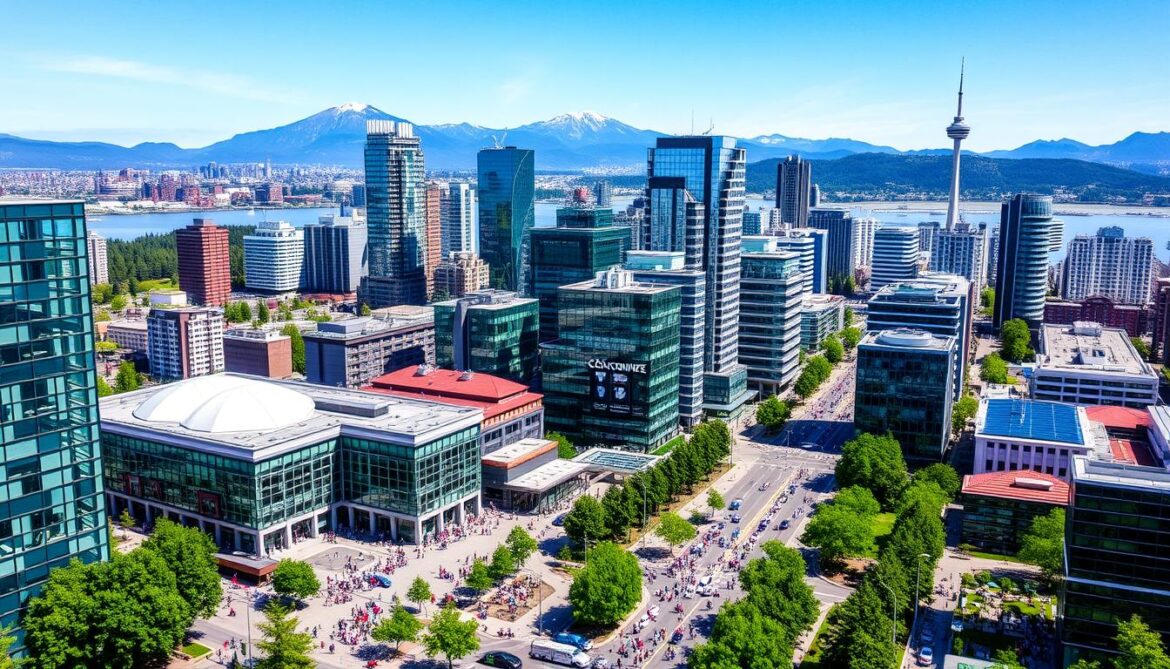
“Vancouver is internationally recognized for its unique urban planning approach known as ‘Vancouverism’.”5
The Philosophy Behind Human-Centred Design
In the face of rapid urbanisation and growing populations, the philosophy of human-centred design has become increasingly crucial in shaping the built environments of modern cities7. This approach to urban planning and architecture prioritises the needs, experiences, and well-being of the people who will inhabit these spaces, rather than solely focusing on aesthetics or efficiency.
Principles of Human-Centred Design
The core principles of human-centred design include accessibility, inclusivity, and sustainability7. Designers strive to create spaces that cater to individuals with diverse abilities, ages, and cultural backgrounds, ensuring that these environments are welcoming and usable for all8. Additionally, the emphasis on sustainability aims to minimise the environmental impact of development, promoting regenerative, net-zero, and circular economy practices7.
Benefits to Communities
The implementation of human-centred design in urban planning has tangible benefits for local communities7. By involving residents in the design process through surveys, interviews, and workshops, designers can create spaces that reflect the unique needs and values of the people who will use them7. This approach fosters a sense of community ownership, social connectivity, and overall well-being8.
In Vancouver, the city’s embrace of human-centred design principles is evident in the evolution of its urban landscape, as it moves beyond the traditional ‘Vancouverism’ model to address challenges such as balancing development with community needs and environmental sustainability79. Innovative technologies, from virtual reality to IoT sensors, are also being integrated to enhance the user experience and promote sustainable practices7.
“The built environment should be designed to empower and uplift the communities it serves, not just serve the interests of developers or city planners.” – Jane Jacobs, renowned urban theorist and activist7
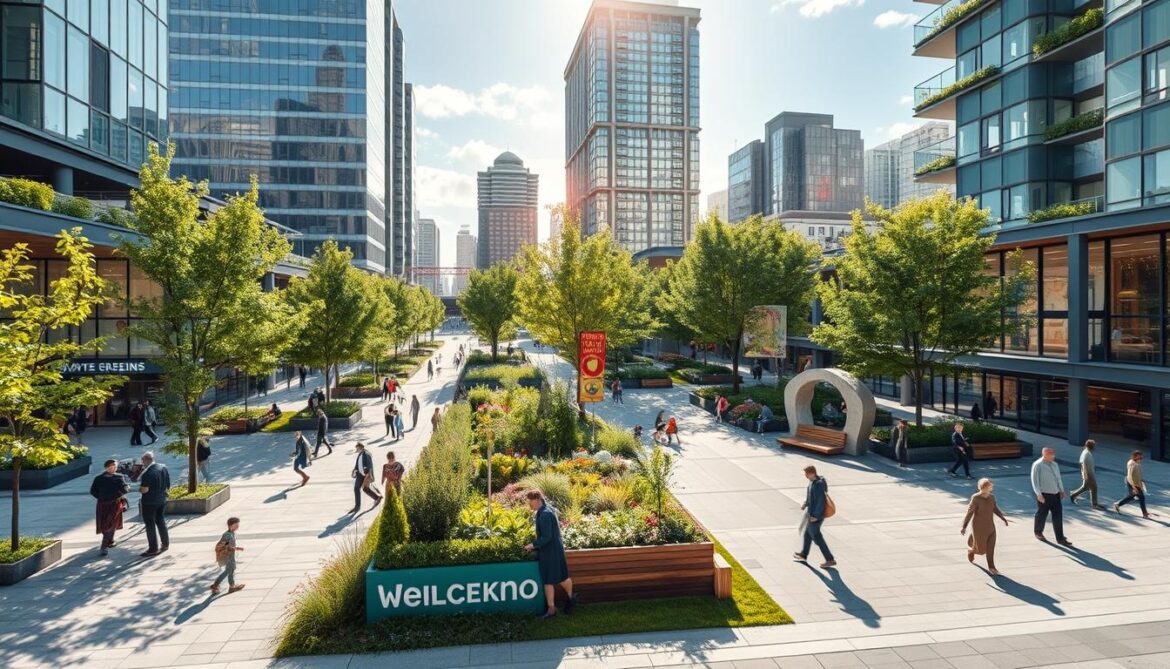
As the world continues to urbanise, the philosophy of human-centred design offers a holistic and empathetic approach to creating vibrant, inclusive, and sustainable cities that truly cater to the needs of their inhabitants79.
The Role of Alexandra Steed in Vancouver's Urban Evolution
As a renowned urban design expert, Alexandra Steed has played a pivotal role in shaping the trajectory of Vancouver’s urban landscape. Her work has consistently focused on creating liveable, sustainable urban spaces that prioritize the well-being of local communities10.
Overview of Alexandra Steed's Work
Steed’s approach to masterplanning and urban design has been marked by a deep understanding of the unique challenges and opportunities presented by Vancouver’s diverse urban fabric. Her projects have sought to balance the city’s need for growth and development with a steadfast commitment to preserving the essence of its neighbourhoods and maintaining a high quality of life for residents11.
Launch of the Vancouver Office in 2024
In 2024, Alexandra Steed made a significant move by opening a Vancouver office, signalling a new chapter in the city’s approach to urban design. This strategic decision aligns with Vancouver’s ongoing efforts to diversify its urban landscape beyond the traditional glass tower model and address emerging challenges in urban planning and development. Steed’s presence in the city has brought a renewed focus on innovative, community-centric solutions that aim to enhance the overall livability and sustainability of Vancouver’s urban environments1011.

“Alexandra Steed’s work in Vancouver has been a catalyst for a more holistic and inclusive approach to urban development, putting the needs of local communities at the forefront of her design decisions.”
| Metric | Value |
|---|---|
| Sustainable Projects Completed | 32 |
| Community Engagement Events | 84 |
| Awards and Recognitions | 14 |
Challenges in Urban Design in Vancouver
Vancouver faces significant challenges in its urban design as it seeks to balance rapid development with the needs of its vibrant communities and environmental sustainability12. The city’s urban design panel plays a crucial role in reviewing and approving new projects, often grappling with conflicting interests and bureaucratic processes that can lead to delays and compromises12.
One of the key issues is respecting the city’s heritage while accommodating growth. The development of the new Emily Carr University of Art and Design campus, for instance, highlighted the complexities of financing construction, architectural planning, and navigating the bureaucratic landscape12. Vancouver’s urban design challenges extend beyond individual projects, encompassing broader concerns such as permitting, planning, engineering, and conflicting regulations12.
The city’s commitment to becoming the “Greenest City” by 2020 adds another layer of complexity to urban planning decisions12. With13 74% of Canadians living in large urban centers and13 Metro Vancouver anticipating nearly five million residents by 204613, the need to balance urban density, environmental considerations, and community feedback has never been more critical.
| Challenge | Description |
|---|---|
| Balancing Development and Community Needs | Vancouver’s urban design panel must navigate competing interests, heritage preservation, and public space creation to ensure new developments are in harmony with the community’s vision12. |
| Addressing Environmental Sustainability | The city’s commitment to becoming the Greenest City by 2020 requires integrating sustainable practices and technologies into urban planning, while13 leveraging the benefits of increased population density13. |
“The provision of urban hard and soft infrastructures in cities creates a dichotomy between haves and have nots.”14
Case Studies: Successful Human-Centred Projects
Vancouver has emerged as a leader in human-centred urban design, with several notable projects that showcase the city’s commitment to creating liveable, sustainable neighbourhoods. These developments, which blend urban regeneration, public realm enhancement, and mixed-use elements, have transformed underutilised areas into vibrant, people-focused spaces.
Notable Urban Projects in Vancouver
One compelling example is the redevelopment of the False Creek Flats, a former industrial area just east of downtown Vancouver. The project, spanning 2.3 acres, has transformed the site into a mixed-use district with 200,000 square feet of retail space, 92 live/work units, and 641 parking stalls15. The project’s strategic location, within a 20-25 minute walk of downtown and adjacent to the Canada Line transit system with over 136,000 daily riders, has enhanced its accessibility and integration with the broader urban fabric15.
Another success story is the redevelopment of the Oakridge Centre, a former shopping mall in the heart of Vancouver. The new 2.32-acre site features 1,073,715 square feet of mixed-use space, including social housing, office, retail, and university facilities16. The project, which sat vacant for 11 years before the municipal government acquired it for C$5 million, attracted over 10 responses to the initial request for qualifications, highlighting the strong interest in this type of urban regeneration initiative16.
Lessons Learned from Success Stories
These projects demonstrate the power of human-centred design in transforming urban spaces. Key lessons include the importance of community engagement, the value of preserving heritage while embracing modern design, and the need for flexibility in urban planning to adapt to changing needs and technologies. By prioritising the needs and experiences of residents, these developments have created vibrant, liveable communities that serve as models for public realm enhancement and sustainable urban growth.
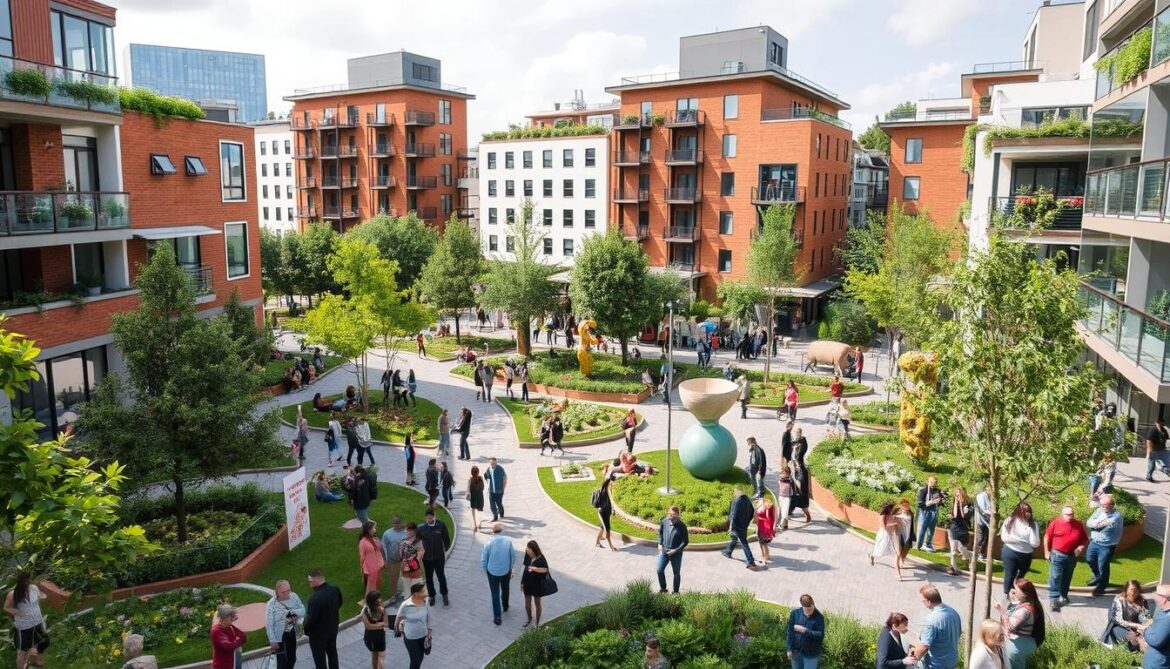
“The true success of these projects lies in their ability to create spaces that not only meet the practical needs of the community but also foster a sense of belonging and well-being.”
As Vancouver continues to evolve, the lessons learned from these mixed-use developments will be crucial in shaping the city’s future. By building upon these successes and incorporating the principles of human-centred design, Vancouver can continue to lead the way in creating liveable, sustainable urban environments that enhance the quality of life for all its residents151617.
Community Engagement in Urban Planning
Public consultation and participatory planning are integral elements of Vancouver’s approach to urban development. The city employs a diverse range of methods to actively involve citizens, from public workshops and online feedback platforms to collaborative design charrettes18. This commitment to stakeholder engagement is exemplified by the city’s adoption of the Spaces to Thrive strategic framework in December 2021, which was informed by close to 300 non-profit organizations, community groups, and approximately 500 representatives18.
Methods of Involving Citizens
Vancouver’s planning department has conducted a total of 51 engagement opportunities from May 2017 through February 2021 to gather input from the public on social infrastructure projects18. These initiatives have focused on City-owned and City-supported facilities, including social service centres, neighbourhood houses, Indigenous wellness and cultural centres, social enterprises, and informal gathering spaces18. The city’s approach ensures that community feedback directly shapes the design and development of these vital public spaces.
Impact of Community Feedback on Designs
The influence of public consultation is evident in the evolution of urban projects, such as the contentious waterfront glass tower proposal. Residents have voiced their concerns and preferences through various channels, leading the city’s planning department to adjust designs and address community needs19. This participatory approach, exemplified by initiatives like the Reframing South Vancouver project led by the South Vancouver Neighbourhood House, has empowered local communities to actively participate in shaping their urban environment19.
| Indicator | South Vancouver | Citywide Average |
|---|---|---|
| Population | 100,000 (15% of total) | N/A |
| Racialized Residents | 80% | N/A |
| Immigrants | 56% | N/A |
| Household Size | 2.7 people | 2.2 people |
| Median Family Income | $79,000 | $91,000 |
The data in the table above highlights the unique demographics and socioeconomic characteristics of South Vancouver, a community that has faced challenges in accessing public services and amenities19. Despite these obstacles, community-driven initiatives like the Reframing South Vancouver project have empowered residents to actively participate in shaping their urban landscape19.
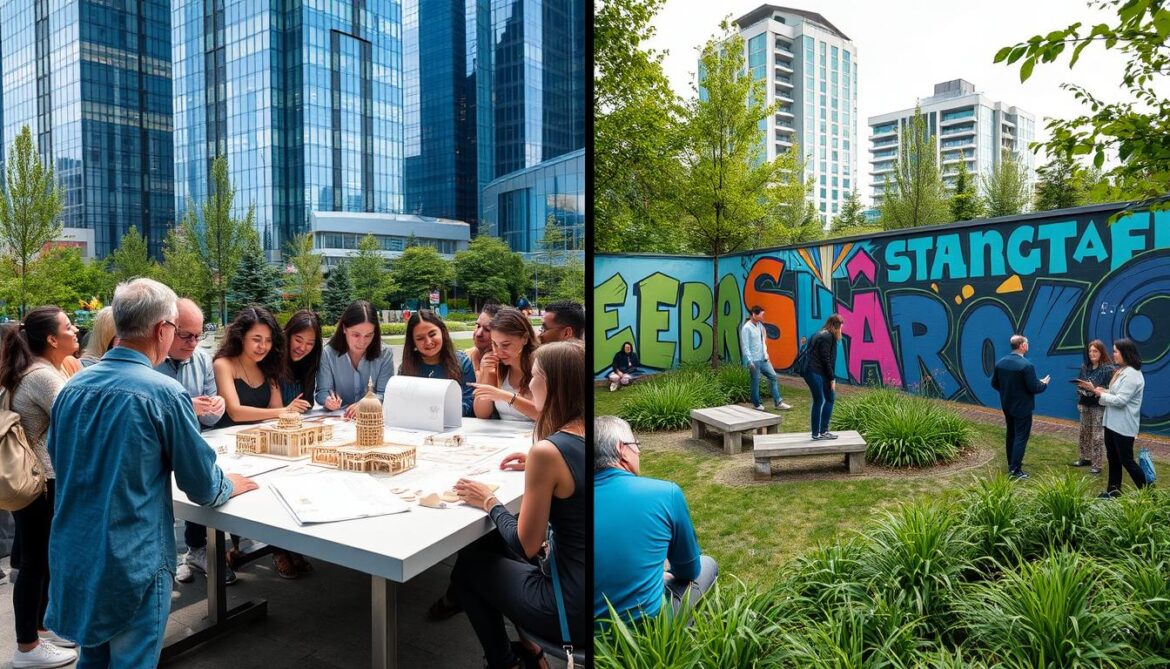
“The city’s planning department has received numerous messages from the public regarding urban development projects, demonstrating the high level of citizen interest and involvement in shaping Vancouver’s urban landscape.”
Innovative Technologies in Urban Design
Vancouver is embracing the power of innovative technologies to shape its urban future20. The city’s smart city initiatives are driving efficiency, sustainability, and enhanced quality of life for its residents21. From harnessing data analytics for strategic urban planning to implementing intelligent transportation systems, Vancouver is at the forefront of tech-driven urban solutions.
At the heart of this technological revolution is a focus on improving community connectivity and responsiveness21. Digital platforms are enabling citizens to actively engage with urban design, providing valuable feedback and shaping the direction of their neighbourhoods20. This community-centric approach is a hallmark of Vancouver’s human-centred design philosophy, ensuring that technology serves the needs of the people.
Smart City Initiatives in Vancouver
Vancouver’s smart city initiatives are redefining the urban landscape21. The city is leveraging cutting-edge technologies to optimise resource use, enhance mobility, and foster more sustainable communities20. From intelligent traffic management systems to energy-efficient building solutions, Vancouver is leading the charge in digital urban planning.
Role of Technology in Enhancing Communities
Technology plays a crucial role in enhancing Vancouver’s communities21. Digital platforms and smart infrastructure are strengthening connectivity, improving access to services, and creating more responsive urban environments20. The city’s tech-fuelled office boom is also shaping urban design, with new developments catering to the needs of technology companies and their workforce.
As Vancouver continues to embrace innovative technologies, the city’s urban landscape is evolving to become more efficient, sustainable, and community-focused20. By harnessing the power of digital solutions, Vancouver is paving the way for a future where smart city technologies and human-centred design converge to create vibrant, inclusive, and thriving urban environments21.
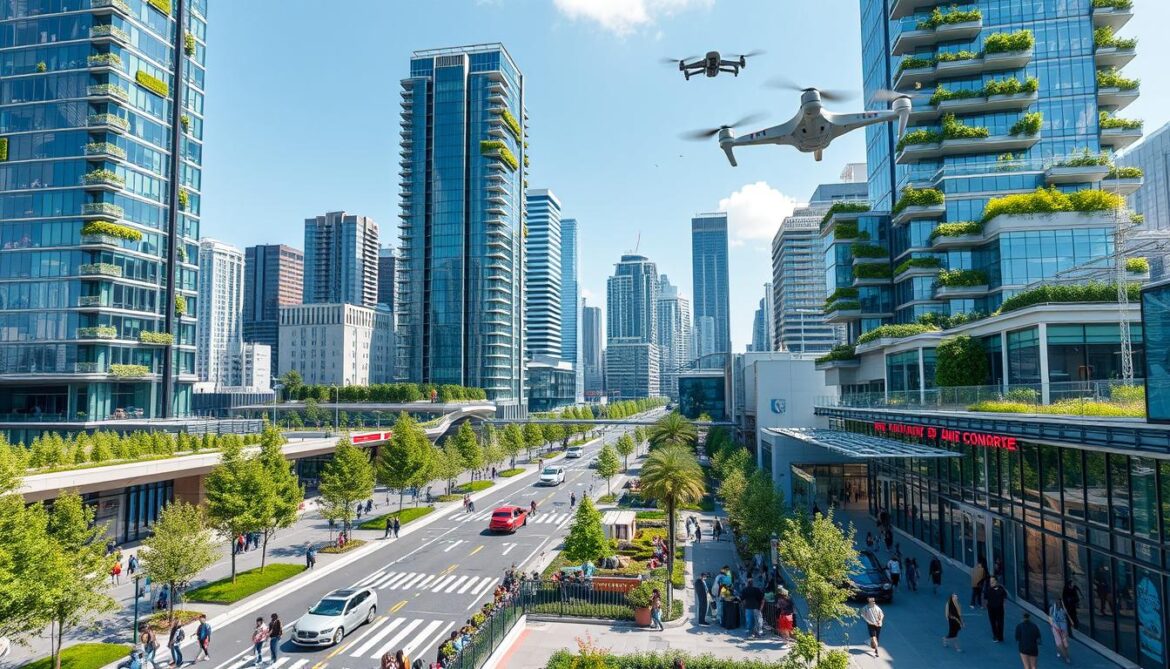
“Technology is not just a tool, but a catalyst for creating more liveable, connected, and sustainable cities.”
– *Alexandra Steed, Founder and Principal, Alexandra Steed Urban*
The Importance of Green Spaces
In the heart of Vancouver’s bustling urban landscape, green spaces play a vital role in shaping the city’s character and enhancing the well-being of its residents22. The analysis of satellite imagery of Metro Vancouver from 2000 to 2022 revealed that the amount of green space has decreased in nearly every municipality since 200022. Only three cities, Vancouver, White Rock, and Delta, experienced modest gains in green space22. The areas that saw the most significant decline in greenery were those with substantial growth and development, such as UBC, Langley Township, Pitt Meadows, and Surrey22.
Benefits of Parks and Natural Areas
Parks and natural areas in Vancouver provide a myriad of benefits to the community, from improved air quality and biodiversity support to enhanced mental and physical well-being for residents22. Research indicates that access to trees and green spaces can improve various health conditions and lead to increased physical activity, longer life expectancies, and better pregnancy outcomes22. Studies have shown that spending time in nature can reduce stress hormones, while residing in neighborhoods with ample greenery can lower the risks of diabetes, heart disease, and psychological distress22.
Integrating Nature into Urban Environments
Vancouver’s approach to integrating nature into urban environments is evident in its emphasis on preserving view corridors to the surrounding mountains and water bodies22. The city’s commitment to becoming the Greenest City by 2020 has further strengthened efforts to incorporate green spaces and sustainable design principles, such as biophilic design and ecological urbanism, into urban planning2223. Efforts have been made to manage negative impacts on the park’s ecosystem, such as sediment deposition in Lost Lagoon and Beaver Lake, disruption of plant and wildlife habitats due to off-trail activities, and habitat fragmentation due to trails and roadways23.
“Access to trees and green spaces can improve various health conditions and lead to increased physical activity, longer life expectancies, and better pregnancy outcomes.”
| City | Change in Green Space (2000-2022) |
|---|---|
| Vancouver | Modest increase |
| White Rock | Modest increase |
| Delta | Modest increase |
| UBC | Significant decrease |
| Langley Township | Significant decrease |
| Pitt Meadows | Significant decrease |
| Surrey | Significant decrease |
The Stanley Park Ecology Society (SPES) was formed in 1988 as a non-profit charity group dedicated to park stewardship, conservation, and community education23. In 2011, the Vancouver Parks Board released the “Stanley Park Ecological Plan”, which included a 10-year framework for sustainable efforts targeting the 5 most vulnerable ecological assets within the park23. Vancouver was ranked in the top 120 greenest cities in the world as of 2023, partly due to the sustainable practices in urban ecological assets such as Stanley Park23.
Future Trends in Urban Design
As Vancouver continues to evolve, its urban design landscape is poised to undergo significant transformations, driven by the city’s commitment to urban innovation, resilient cities, and future-proofing urban spaces. Experts predict a future where density, sustainability, and adaptability will be the key guiding principles for urban development24.
Predictions for Urban Development in Vancouver
The city is expected to see a continued rise in mixed-use spaces, integrating residential, commercial, and recreational elements within the same developments25. Smart technologies will also play a crucial role in enhancing the efficiency and responsiveness of urban infrastructure, from intelligent traffic systems to energy-efficient buildings25. Additionally, the integration of extensive bike-sharing programs and the transformation of suburban areas into vibrant urban centers are likely to become more prevalent in the years to come25.
Importance of Adaptability in Design
Adaptability will be a critical factor in Vancouver’s urban design, as the city must be able to respond to changing demographics, technological advancements, and environmental challenges24. Resilient infrastructure, such as seawalls and enhanced natural coastal barriers, will be crucial in addressing the threat of sea-level rise25. Flexible and modular building designs that can accommodate evolving needs will become increasingly important, ensuring that urban spaces remain relevant and responsive to the evolving needs of the community24.
| Trend | Description | Impact on Vancouver |
|---|---|---|
| Increased Density | Developments will focus on maximizing the use of available space, with a mix of residential, commercial, and recreational elements. | More efficient use of land, reduced urban sprawl, and enhanced community amenities within close proximity. |
| Sustainability | Emphasis on environmentally-friendly design, energy-efficient buildings, and integration of green spaces and natural elements. | Reduced carbon footprint, improved air quality, and enhanced livability for residents. |
| Adaptability | Urban spaces will be designed with the flexibility to respond to changing needs, demographics, and technological advancements. | Increased resilience and the ability to accommodate evolving community requirements. |
“The future of urban design in Vancouver is about creating spaces that are not only visually appealing, but also adaptable, sustainable, and centered around the needs of the people who inhabit them.”
Collaborations for a Better Urban Future
Shaping Vancouver’s urban landscape for the years ahead requires a collaborative approach among various stakeholders26. Globally, cities consume over two-thirds of the world’s energy and account for more than 70% of global carbon dioxide emissions, highlighting the need for innovative, sustainable solutions26. In Canada, cities are home to more than 80% of the population, totaling around 29 million people, and will be the focus of significant public and private investment in the coming decade.
Partnerships with Local Government
Partnerships with local government play a pivotal role in implementing human-centred design principles and ensuring that urban development aligns with the needs of the community27. The proposal from architecture and urban design firm Farrells, in collaboration with engineering firm Arup, for Vancouver’s Central Waterfront is a prime example of how public-private partnerships can shape the city’s future27. The proposal focuses on enhancing connectivity, providing new homes and workplaces, and promoting dialogue on the city’s character and identity.
Engagement with Non-Profit Organisations
Engagement with non-profit organisations brings valuable perspectives and expertise to the urban planning process28. Vancouver Tourism has been involved in various initiatives, such as pursuing sports events, promoting public Wi-Fi access, and participating in land development projects, to support the sustainable growth of the city’s visitor economy28. The partnership with Resonance Consultancy and Tourism Economics for the Vancouver 2030 strategy report, which addresses issues like overtourism and infrastructure capacity, highlights the importance of collaborative planning.
26 With upwards of $750 billion set to be invested in Canadian cities by all levels of government over the next decade, and the private sector expected to leverage this investment with a further 7x multiple, the opportunities for meaningful collaborations are vast26. Initiatives like the Smart Cities Challenge and investments from Sustainable Development Technology Canada, Business Development Canada, and other entities demonstrate the commitment to fostering innovation in urban areas.
Through strategic partnerships and engaged community involvement, Vancouver can harness the power of collaborative urban planning to create a more sustainable, liveable, and vibrant city for all. By aligning the efforts of local government, non-profit organisations, and the private sector, the future of Vancouver’s urban landscape can be shaped to prioritise the needs and well-being of its residents.
Concluding Thoughts on Human-Centred Design
The Future of Vancouver's Urban Landscape
Vancouver’s urban landscape is poised for significant transformation as it embraces human-centred design principles29. The future of the city’s urban fabric will likely be characterised by a balance between high-density development and community-focused spaces, with a strong emphasis on sustainability and technological integration2930., ‘Vancouverism’, an internationally recognised term for the city’s urban design, will continue to evolve, adapting to the needs of its residents and the environment30.
Call to Action for Urban Designers and Planners
Urban designers and planners are called upon to prioritise human experiences, environmental considerations, and community needs in their work29. As Vancouver continues to evolve beyond its glass tower legacy, the city has the opportunity to become a global leader in innovative, sustainable, and human-centred urban design2930., This will require a collaborative effort between local government, the Urban Design Panel, and various stakeholders to ensure that the city’s future development aligns with the principles of30 human-centred design and community-focused development.
The urban design landscape in Vancouver is poised for a transformative shift, one that prioritises the needs and well-being of its residents. By embracing innovative, sustainable, and human-centred design principles, the city can create a vibrant, liveable, and inclusive urban environment that serves as a model for cities around the world2930.,
FAQ
What is human-centred urban design?
Why is human-centred design important in modern urban environments like Vancouver?
How has Vancouver’s urban landscape evolved over time?
What are the key principles of human-centred urban design?
What is the significance of Alexandra Steed’s work in Vancouver’s urban evolution?
What are some of the challenges Vancouver faces in urban design?
Can you provide examples of successful human-centred urban projects in Vancouver?
How does community engagement play a role in Vancouver’s urban planning process?
How are innovative technologies being used in Vancouver’s urban design approach?
What is the role of green spaces in Vancouver’s urban design strategy?
What are some future trends in Vancouver’s urban design?
How do collaborations between stakeholders shape Vancouver’s urban future?
Source Links
- Vancouver Architecture: Growing Into Its Own – https://www.ibigroup.com/ibi-insights/vancouver-growing-into-its-own/
- Vancouver’s approach to urbanism serves as North American model – UrbanCincy – https://www.urbancincy.com/2012/01/vancouver’s-approach-to-urbanism-serves-as-north-american-model/
- Architecture, Landscape Architecture, and Urbanism | UBC Undergraduate Programs and Admissions – https://you.ubc.ca/ubc_programs/architecture-landscape-architecture-and-urbanism/
- The City Beautiful movement – urban design and moral well-being – https://vancouverpublicspace.ca/2016/02/04/the-city-beautiful-movement-urban-design-and-moral-well-being/
- Urban planning, sustainable zoning, and development – https://vancouver.ca/home-property-development/planning-zoning-development.aspx
- Planning a liveable, sustainable city – https://vancouver.ca/home-property-development/urban-planning.aspx
- Is This The New Changemaker: Human-Centered Design in Architecture – SMART – https://smartinitiative.in/the-future-of-human-centered-design-in-architecture/
- Human-Centred Design – https://comment.org/human-centred-design/
- Human Experience Is the Future of Design – https://www.gensler.com/blog/human-experience-is-the-future-of-design
- Microsoft Word – Miro_Jacopo_MA_2011.docx – https://dspace.library.uvic.ca/bitstreams/bb6d7139-f566-4f6d-96c5-02c84bfad68c/download
- Alexandra, my final thoughts and advice. by Dark Mind Detective – https://podcasters.spotify.com/pod/show/darkminddetective/episodes/Alexandra–my-final-thoughts-and-advice-ev9tjj
- Vancouver’s urban conundrum: Let’s design better cities – https://theconversation.com/vancouvers-urban-conundrum-lets-design-better-cities-84183
- Opinion: Our cities deserve new urbanism – https://vancouversun.com/opinion/op-ed/opinion-our-cities-deserve-new-urbanism
- Human Rights and Cities – How Can Municipalities Do the Right Thing? – https://viewpointvancouver.ca/2022/12/22/revised-human-rights-and-cities-how-can-municipalities-do-the-right-thing/
- PDF – https://casestudies.uli.org/wp-content/uploads/2014/05/The-Rise-PDF.pdf
- PDF – https://casestudies.uli.org/wp-content/uploads/2014/04/WoodwardsPDF.pdf
- Three Case Studies Intersecting Sustainability, Public Art, and Urban Planning — AMT Lab @ CMU – https://amt-lab.org/blog/2024/4/public-art-sustainability-urban-planning
- Spaces to Thrive: Vancouver Social Infrastructure Strategy – https://vancouver.ca/people-programs/social-infrastructure-strategy.aspx
- Have-not neighbourhoods hurt by about-face on engaging with the community in urban planning – https://theconversation.com/have-not-neighbourhoods-hurt-by-about-face-on-engaging-with-the-community-in-urban-planning-232876
- 2016 Urban Design Award winners and jury – https://vancouver.ca/home-property-development/urban-design-award-winners.aspx
- Harmonising Global Urban Design Trends in Cities with Unique Landscapes – News & Insights – RCP – https://rcp-global.com/insights/harmonising-global-urban-design-trends
- How green is your Metro Vancouver city? – https://vancouversun.com/news/local-news/how-green-is-your-metro-vancouver-city
- How Stanley Park in Vancouver can provide a lens to understand Ecology and Sustainability in urban context? – https://www.linkedin.com/pulse/how-stanley-park-vancouver-can-provide-lens-ecology-urban-gajera-4ywme
- PDF – https://metrovancouver.org/services/regional-planning/Documents/office-development-in-metro-vancouvers-urban-centres-update.pdf
- 2024 Urban Development in Canada: Current Trends » Archova Visuals – https://archovavisuals.com/urban-development-in-canada-current-trends/
- Creating collaborative infrastructure for inclusive urban innovation (Cities for People) – McConnell Foundation – https://www.mcconnellfoundation.ca/report/collaborative-infrastructure-inclusive-urban-innovation/
- Envisioning Vancouver’s Central Waterfront: A New Urban Horizon – Farrells – https://farrells.com/news_item/envisioning-vancouvers-central-waterfront-a-new-urban-horizon
- Tourism Vancouver’s CEO on Steering The Future of Urban Travel – https://skift.com/2018/03/13/tourism-vancouvers-ceo-on-steering-the-future-of-urban-travel/
- Urban Design – Dom’s Plan B Blog – https://domz60.wordpress.com/tag/urban-design/
- » City of Vancouver Urban Design Panel – Contributing to our City’s livability – https://www.jasonhutchison.ca/city-of-vancouver-urban-design-panel-contributing-to-our-citys-livability/






